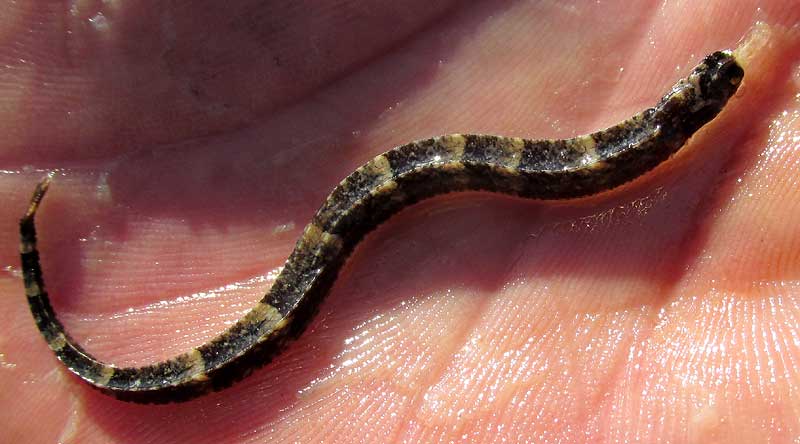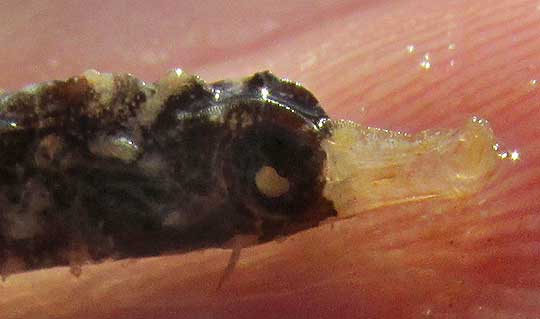Excerpts from Jim Conrad's
Naturalist Newsletter

from the March 1, 2015 Newsletter issued from Río Lagartos, on the Yucatan Peninsula's northern coast (~N21.60°, ~W88.16°), Yucatán state, MÉXICO
WHITENOSE PIPEFISH
That day wading through a submerged field of aquatic Shoalgrass during a very low tide, we were finding so many amazing things that when Rayo spotted and caught a brown, wormy-like thing shaken loose from a Shoalgrass blade he didn't get excited at all, but still he showed it to me because it was something different. But as soon as a closer look was taken it was clear that if this was a worm it was a very strange one. That's it above.
Other worms we were finding were segmented, but this organism wasn't. Even more surprising, its body had corners, and one end was tipped with a pale, peg-like appendage. Out came the hand lens for a better look at that pale tip, and I saw what's shown below:

The pale thing looked a little like a duck's beak, and right behind it was a depression in which there might have been an eye. And right below and a little to the left of the eye, is that pale, slender thing projecting downward a fin? In fact, atop the critter, behind the eyes, isn't that a kind of top fin, maybe like a fish's dorsal fin?
Gradually it occurred to me that the head looked just like a seahorse's, but of course seahorses have potbellies and slender tails that curl below them. Finally I remembered that there's something called a pipefish, which is like a straight seahorse without a potbelly, and surely that's what we had.
On the Internet we began ordering our thoughts about the world of seahorses and pipefishes. Seahorses and pipefishes are real fish, though highly modified and adapted ones, belonging to the Seahorse and Pipefish Order Syngnathidae. Fish in this family possess long, narrow bodies surrounded by a series of bony rings, and they have small, tubular mouths. In evolutionary terms, that last feature is a huge deal. In fact, the "syngnath" in the family's name Syngnathidae is derived from the Ancient Greek "syn" meaning "together," and "gnathos" meaning "jaw."
The Family Syngnathidae is divided into two subfamilies, one containing seahorses, and the other pipefishes. But, beyond this point, experts don't agree on which organisms belong to which genus and species, and it's surprising that so little information is available of the kind we like to pass along here.
By consulting lists of pipefish species thought to occur in our general area, and by comparing our pictures with those on the Internet -- a sloppy approach but the best we have at this time -- our wormlike discovery was found to be the Banded Pipefish, HALICAMPUS CRINITUS*.
*UPDATE: In 2024 when I upload this page's photos to iNaturalist, user "coralreefdreams" recognized the Whitenose Pipefish, COSMOCAMPUS ALBIROSTRIS, occurring along the Atlantic and Caribbean coasts from the US's southern Atlantic states south to northern South America, then again on the southern Brazil coast.
Wikipedia provides an informative Cosmocampus albirostris page.
Beyond that, interesting facts are known about pipefishes in general. For instance, the series of bony rings covering pipefish bodies makes them so rigid that instead of bending their bodies back and forth to swim like normal fish, pipefish swim by rapidly fanning their fins. You can see that our pipefish's fins are very small, which helps to explain why ours was so easy to catch. Still, pipefishes can control their movements with great precision, and can hover in place for a long time.
Among both seahorses and pipefish, females lay their eggs the usual way, the males fertilize them, and then those males carry the eggs during incubation. Male pipefish either carry the eggs in a specialized pouch on the bottom of their bodies, in their ventral pouch, or else attach the eggs to their tails, the technique depending on the species.
Despite having mostly fused jaws, pipefish are predators who eat live foods such as brine shrimp, small ghost shrimp, copepods and amphipods. Their jaws are not entirely fused, however. The elongate, tubular snout formed by the fused parts of their jaws ends with tiny, toothless jaws at the end of the snout. This mouth configuration enables the pipefish to do a fast and powerful kind of feeding referred to as "pivot feeding." Pivot feeding involves rotating the snout at a very high speed, employing a kind of poorly understood "trigger mechanism," resulting in small prey being sucked in.